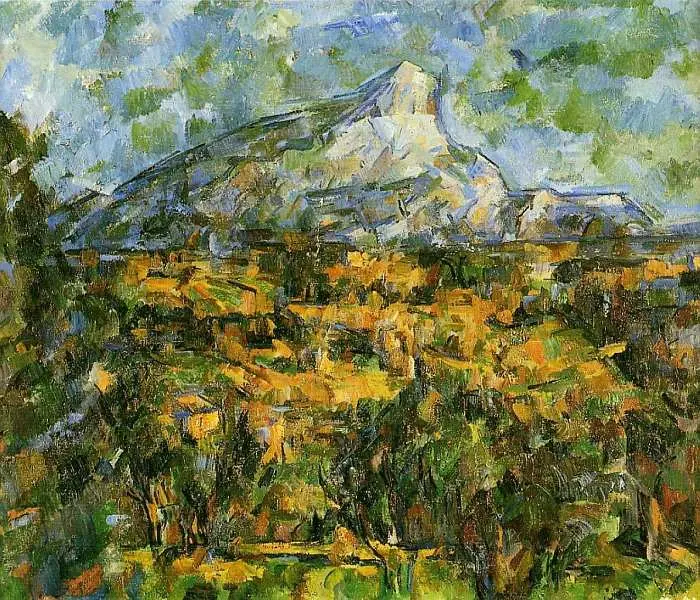log in
Enter site
Login to use Arthive functionality to the maximum
Landschaft in Aix, Mount St. Victoria (Mount St. Victoire)
Paul Cezanne • Malerei, 1905, 60×73 cm


















Bildbeschreibung «Landschaft in Aix, Mount St. Victoria (Mount St. Victoire)»
Dieses Gemälde von Paul Cezanne ist für sie einer der seltenen Schätze des Museums. Puschkin. Dies ist das neueste Bild von Mount Victoria, das Paul Cezanne ein Jahr vor seinem Tod geschrieben hat. Symbolische Dämmerungslandschaft, das Ergebnis einer zwanzigjährigen Suche und Untersuchung. Seit Mitte der 1880er Jahre schrieb Cezanne den Mount Victoria mehr als 80 Mal.
Nach und nach befreit Cezanne das Bild von unnötigen Details, findet die richtigen Proportionen und löst die natürlichen Grenzen zwischen Bäumen, Häusern, Bergen und Himmel auf. Dabei findet er eine fast abstrakte, mystische Essenz. Cezanne bewegt sich allmählich von seiner eigenen Vision zur künstlerischen Ordnung und von der Ordnung zur ursprünglichen "Idee des Berges".
Der Biograf von Cezanne, Alex Danchev, sagt, dass der Künstler "nicht so sehr Topografie als psychogeografische Herkunft zeigte, sondern nicht ein Landschaftsmaler, der in ihm lebte, sondern ein Geologe oder vielleicht ein Archäologe." Um den Unterschied zu spüren, schauen Sie sich einfach die Bilder dieser Orte oder die Bilder der Berge von anderen Künstlern an. Zum Beispiel der ImpressionistRenoir ("Mount Saint Victoire").
Cezannes Fans, Künstler, Kritiker und das Publikum sind gleichermaßen schwer zu erklären, wie er diesen monumentalen Effekt suchte. Es hilft weder bei der Analyse von Techniken noch bei deren professioneller Wiederholung. Sie sprachen über Cezanne als einen Propheten, als einen Mann, der die Natur nicht verstehen, sondern sich ihr stellen konnte. Über sichtbare Unvollkommenheiten seiner WerkeVictor Shoke sagte einmal wie "über Verbesserungen, die aus der Breite des Wissens entstehen". Eine ganze Generation modernistischer Künstler, gewachsen und gestärkt unter dem Einfluss von Cezanne, wiederholte sich im Einklang: Er schrieb nicht den Apfel, sondern die Seele des Apfels, er schrieb nicht den Berg, sondern das Wesen des Berges.
Ohne zu versuchen, Cezannes Fähigkeit zu verstehen, die Essenz der Dinge mit seinem eigenen geschickt geschärften Bildinstrument zu enthüllen, kann man dennoch einige technische und kompositorische Techniken in Betracht ziehen, die seinen späten Werken eigen sind. Und insbesondere die neuesten Bilder des Mount Victoria.
In den letzten Jahren arbeitet Cezanne viel mit Aquarell - und überträgt nach einer Weile Aquarelleffekte auf ihre Arbeiten mit Öl. Die Farben werden dünn und transparent aufgetragen und die Leinwand bleibt an einigen Stellen unbemalt. Einzelne Farbfelder kreuzen sich nicht.
Irgendwo hier beginnt der Kubismus, als bestünde er aus einem Mosaik aus Himmel und Gras. Dies ist eine Welt, in der der Künstler allgegenwärtig ist - er befindet sich in der Landschaft und kann jedes interessierende Objekt von mehreren Seiten betrachten, sich drehen und sich nicht mit einer direkten Perspektive zufrieden geben.
Irgendwo hier, an der Kreuzung multidirektionaler, dynamischer Striche, bricht die sichtbare Welt zusammen, bricht jedoch nicht zusammen, sondern wird aktualisiert und lässt den Expressionismus ahnen. Und hier, in den kaum zu unterscheidenden Umrissen von Bäumen, Erde und Himmel, existieren bereits alle Voraussetzungen für die Ideen der abstrakten Kunst, wobei die Farbe selbst die semantische und emotionale Energie des Bildes ist.
Autor: Anna Sidelnikova
Nach und nach befreit Cezanne das Bild von unnötigen Details, findet die richtigen Proportionen und löst die natürlichen Grenzen zwischen Bäumen, Häusern, Bergen und Himmel auf. Dabei findet er eine fast abstrakte, mystische Essenz. Cezanne bewegt sich allmählich von seiner eigenen Vision zur künstlerischen Ordnung und von der Ordnung zur ursprünglichen "Idee des Berges".
Der Biograf von Cezanne, Alex Danchev, sagt, dass der Künstler "nicht so sehr Topografie als psychogeografische Herkunft zeigte, sondern nicht ein Landschaftsmaler, der in ihm lebte, sondern ein Geologe oder vielleicht ein Archäologe." Um den Unterschied zu spüren, schauen Sie sich einfach die Bilder dieser Orte oder die Bilder der Berge von anderen Künstlern an. Zum Beispiel der ImpressionistRenoir ("Mount Saint Victoire").
Cezannes Fans, Künstler, Kritiker und das Publikum sind gleichermaßen schwer zu erklären, wie er diesen monumentalen Effekt suchte. Es hilft weder bei der Analyse von Techniken noch bei deren professioneller Wiederholung. Sie sprachen über Cezanne als einen Propheten, als einen Mann, der die Natur nicht verstehen, sondern sich ihr stellen konnte. Über sichtbare Unvollkommenheiten seiner WerkeVictor Shoke sagte einmal wie "über Verbesserungen, die aus der Breite des Wissens entstehen". Eine ganze Generation modernistischer Künstler, gewachsen und gestärkt unter dem Einfluss von Cezanne, wiederholte sich im Einklang: Er schrieb nicht den Apfel, sondern die Seele des Apfels, er schrieb nicht den Berg, sondern das Wesen des Berges.
Ohne zu versuchen, Cezannes Fähigkeit zu verstehen, die Essenz der Dinge mit seinem eigenen geschickt geschärften Bildinstrument zu enthüllen, kann man dennoch einige technische und kompositorische Techniken in Betracht ziehen, die seinen späten Werken eigen sind. Und insbesondere die neuesten Bilder des Mount Victoria.
In den letzten Jahren arbeitet Cezanne viel mit Aquarell - und überträgt nach einer Weile Aquarelleffekte auf ihre Arbeiten mit Öl. Die Farben werden dünn und transparent aufgetragen und die Leinwand bleibt an einigen Stellen unbemalt. Einzelne Farbfelder kreuzen sich nicht.
Irgendwo hier beginnt der Kubismus, als bestünde er aus einem Mosaik aus Himmel und Gras. Dies ist eine Welt, in der der Künstler allgegenwärtig ist - er befindet sich in der Landschaft und kann jedes interessierende Objekt von mehreren Seiten betrachten, sich drehen und sich nicht mit einer direkten Perspektive zufrieden geben.
Irgendwo hier, an der Kreuzung multidirektionaler, dynamischer Striche, bricht die sichtbare Welt zusammen, bricht jedoch nicht zusammen, sondern wird aktualisiert und lässt den Expressionismus ahnen. Und hier, in den kaum zu unterscheidenden Umrissen von Bäumen, Erde und Himmel, existieren bereits alle Voraussetzungen für die Ideen der abstrakten Kunst, wobei die Farbe selbst die semantische und emotionale Energie des Bildes ist.
Autor: Anna Sidelnikova
Empfohlene Kunstwerke:























